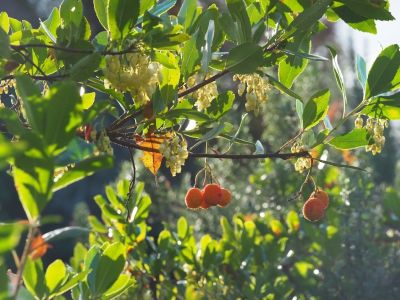

Whatever happened to winter? - January 2023
We tend to focus our gardening efforts on summer, even though most of the floral interest is in ‘spring’. In summer we expect - and usually get - hot and dry weather. There may be summer storms, but this water mostly runs off. We worry about how to cope with summer ‘drought’, but it is always hot and dry in summer so can this regular event really count as ‘drought’?

View across the Nestore valley in summer
Winter is, by contrast, a precious time: gentle light from a sun that is low in the sky. A time for repose, regeneration and – most importantly – rain. A time for planning and planting and pruning. A time to savour small delights, and colour in different forms.

Same view across the Nestore valley in winter
Winter matters, and whether it is wet, dry, snowing, warm, freezing, windy … it controls the growing season in the following spring.

Oblique sunlight on Arbutus fruit and flowers
Our appreciation of colour Is more sophisticated in winter and we notice little details, such as the bronze leaf tips of tall Cistus ladanifer. As the great prairie plantsman Piet Oudolf observed: “Brown is also a colour”.
But we also enjoy the intense colour of the little bulbs that bloom in late January.
In the first six months of 2022, central Italy received only 50% of the amount of rain that would normally be expected to fall. September floods were not enough to re-fill Lake Trasimeno and the water level remained frighteningly low. October was warm and dry, no rain at all. Happily, November got some rain and the Lake level rose a little – at long last. December was very wet so now the lake is higher but still at -1.2m below the ‘normal’. And in 2023 we are experiencing Dry January.
Is this winter drought going to be the norm? Should we water our gardens in winter? Our gardens and the agricultural crops all rely on the winter rains. Let it snow.
“If winter comes, can spring be far behind?”
Ode to the West Wind, composed by Percy Bysshe Shelley 1819 whilst visiting the Parco delle Cascine near Firenze.

Flowers and berries collected on 11th January 2023
If you go out into the garden today and look around, I believe that you will be surprised at the range of flowers blooming even now at this dark time. You need to look carefully because some are quite small. Others are easily dismissed as ‘common’ plants, but I believe they are precious nonetheless.
This afternoon I have picked a bunch of flowers in my garden:
Anemone coronaria, Anisodontea malvastroides, Coronilla glauca, Iris unguicularis (Algerian Iris), Lavandula dentata, Jasminum nudiflorum (Winter Jasmine), Lonicera fragrantissima (Winter Honeysuckle), Rosa ‘Zepherine Drouhin’ and ‘Lady Hillingdon’, Rosmarinus ‘Majorcan Pink’, Teucrium fruticans ‘Azureum’, Ulex europeus (Gorse), Viburnum tinus ‘Eve Price’
Not to mention branches of colourful berries from Arbutus, Cotoneaster, Juniper and Pyracantha.
Watch me talking about the garden in winter to a meeting of the Mediterranean Garden Society Italy branch
The photo at the top of this page shows a honey bee visiting Lonicera fragrantissima in mid-winter
Many of these articles first appeared in the Castiglione del Lago monthly newsletter “Qua e là” edited by Priscilla Worsley
All text and photographs © Yvonne Barton unless stated otherwise